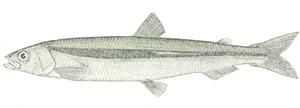Surf Smelt

Species Details
Hypomesus Pretiosus
Osmeridae
Osmeriformes
Inshore
1 - 1 lbs.
12"
Surf Smelt (Hypomesus pretiosus) Fish Description
Surf Smelt are considerably small fish. They have silver streamlined bodies with two dorsal fins. The first dorsal fin being quite flat and middling on its body, and the second dorsal being small and situated far closer to their deeply forked tail fin.
In distinguishing male Surf smelt from female Surf smelt is through their coloration, as the male Surf smelt have brown backs and yellow-like underside, and females having a green back and a white underside. And an additional way of distinguishing them apart is that male Surf smelt have tubercles on their flanks. However, regardless of sex, they both have a dark vertical line that runs down their sides.
Diet & Size
Surf Smelt predominantly feeds on small crustaceans, but can also consume polychaete worms, larval fish, and jellyfish. They can grow to the maximum length of about 12 in. and weigh 1/10th of a pound.
Interesting Facts about Surf Smelt
- Surf Smelt are one of the 9 other species of small forage fish within the Salish Sea.
- They can live up to 5 years of age.
- Surf Smelt are pretty weird fish, especially when laying their eggs. As they would run onwards within breaking waves closing in on the peak of an incoming tide towards the beach to lay their eggs on the sand and return to sea hitchhiking a ride from the next wave.
- Surf Smelt are delicious to eat for humans, fish and other species alike! As they are nearly eaten by everything bigger than they are, ranging from salmon, sea birds, and even porpoises.
- They serve as an important role in the diets of some endangered species, such as the Chinook salmon and tufted puffins.
Fishing Techniques
Experienced anglers at surf areas cam make it a business of watching for bird and sea lion activity, as they can send in a tip to where the school of Surf smelt would be located at. You can spot Surf Smelt as horizontal, dark lines within lazy rolling waves running into shore alternatively to the bigger breakers that lead the set of waves.
They can be caught in succession through several waves, then would suddenly disappear or taper off temporarily, and return again without much of a warning. Anglers who game fish Surf smelt would gather these fish from shores or pier using nets, such as gill nets, dip nets, or throw nets. You can use any of the three, just don’t by any means stand in the surfs and net at the waves, this would cause too much of a ruckus or commotion that would scare off the Surf smelt from coming your way.
Surf Smelt are active although April till October, but you can witness the most movement from June through August. Their runs often happen every day during the summertime and localized in area and, at times, tend to be inconsistent. Best to check in with our local guides for more information on when it would be best to plan a trip for fishing for these wonderful, weird creatures.
Habitat and Distribution
Surf Smelt are often found in the more coarse, black sand beach. Some, even considered to be the best spots, are in freshwater streams entering the Pacific.
They commonly range from areas like Prince William Sound, Alaska to Long Beach, California. However, there is a decline in their population in the south area of San Francisco.
a range from Prince William Sound, Alaska to Long Beach, California, although its population declines south of San Francisco.







